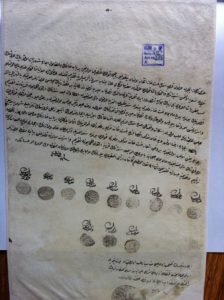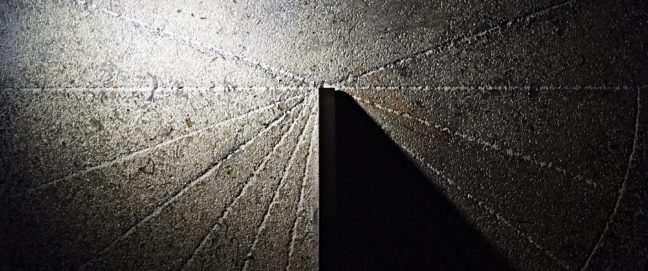Documenting the historical practice of Muslim philanthropy shines a light on the moral values of humanity that can illuminate the past, present and future
What does an historian of the 15th-16th century Ottoman Empire have to say to scholars and practitioners of Islamic philanthropy in the early 21st century? Is there a cogent message for philanthropy managers, financial advisers, fundraisers, and programme personnel of the present and the future from those who focus on the past? The answers are, respectively, ‘quite a lot’ and ‘yes!’.
The Ottoman era is uniquely well-documented among Islamic societies of the past, yet there is still so much lost from the Ottoman and other eras that we have an incomplete notion of how powerful an engine philanthropy was for sustaining Islamic culture and societies over the centuries.

Ottoman document held in the National Library of Bulgaria. Credit@ hazine.info
Beneficent giving, the sadaqa recommended to Muslims, was and is an inseparable ethical component of Islam. In this sense, faith frames philanthropy. The historical study of Muslim philanthropy offers a unique perspective on the organization and perpetuation of human societies. Specifically, it is a window on to the influence of Muslim teachings, social hierarchies and moral values. Philanthropy is one aspect of Islamic history that ties it to the universals of human history. A knowledge of history is fundamental to our understanding of beauty and order, ugliness and chaos in our own world. History connects us to humanity over time and allows us to be proud of our accomplishments and to look at what others have achieved with humility and respect.
So, spare a few moments for a professional nerd who has spent years reading documents from the 15th and 16th centuries, wandering through city and countryside, poring over maps and visiting buildings or their remnants – all in pursuit of answers to questions about how the Ottoman sultans, men and women of the Ottoman elites, and people with some funds to spare practised philanthropic giving. How and why did they choose to endow mosque complexes as the core engine of social, cultural and economic development in cities and towns? Who benefitted from these buildings and their activities? And why are they still with us hundreds of years later?
Our only hope of answering these questions is through the written records of their founding and management, their material remains, and the written and visual accounts of those, locals and travellers, who encountered them. The Ottoman era is uniquely well-documented among Islamic societies of the past, yet there is still so much lost from the Ottoman and other eras that we have an incomplete notion of how powerful an engine philanthropy was for sustaining Islamic culture and societies over the centuries.
Paper records and physical remains have often been destroyed or damaged, accidentally or intentionally, as a result of human violence, natural disasters, or simply the accidents of time. Of all the forms of philanthropy, endowments (waqf) have left a relatively dense paper trail in their foundation deeds, account registers and other more general forms of Ottoman documents such as court records (sijill), land and revenue surveys (tapu tahrir defterleri), and imperial orders (firman, hükum). They help us understand how waqf properties were managed, how finances worked (or didn’t), how employees were chosen, projects funded and what interrupted or prevented successful operations. In addition, buildings like mosques, madrasas, tombs, caravansarais, baths, libraries, public kitchens and fountains are material evidence of the physical impact of endowments on their human and natural environments, even into the 21st century.
Together, they create a more thorough appreciation of the complex ways in which philanthropy has contributed to shaping Muslim culture and society and establish a richer narrative of human history.
Why is it important that these records exist for scholars to study today? Without all this evidence, we would have no story to tell about the Ottomans and their achievements from their own perspective. What would remain are external records, the accounts of outsiders, often observing through the blurred lens of incomplete or false information, further confused by misconceptions and other biases.
Today, we have the possibility of documenting our written, visual, spatial and sound actions on paper, on film and in sound recordings, with digital images whose copies cost nothing and can be easily moved and stored in many separate locations. The main condition for their accessibility in the future is that they be archived professionally in dedicated repositories whose chief concern is to preserve, catalogue and protect them. Digital archives must be updated continually to make them accessible with each new development in hardware and software.
Together with the philanthropic endeavours themselves, their archives will be a legacy of what philanthropy is doing today. What will be the value for the future of good documentation today? Practitioners will be able to examine detailed records to understand better the strengths and weaknesses of specific projects. Philanthropy managers will have more extensive records of what they are managing, and will themselves contribute to extensive institutional memory.
Ultimately, historians will have a more complete body of evidence from which to understand the past and write about its achievements. Their writings, as well as podcasts, documentaries, museum exhibits and digital reconstructions will continue to explain philanthropic achievements. Together, they create a more thorough appreciation of the complex ways in which philanthropy has contributed to shaping Muslim culture and society and establish a richer narrative of human history.
Amy Singer is professor of Ottoman studies at Tel Aviv University.
Email asinger@post.tau.ac.il







Comments (0)